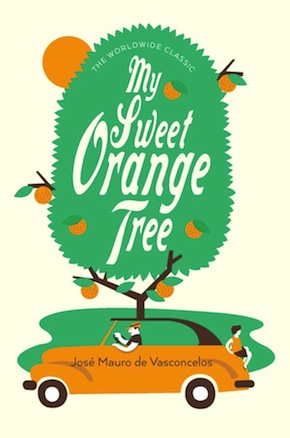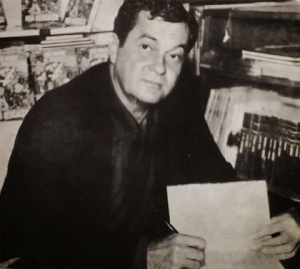Blossoming on
by Alison Entrekin
“A near-perfect child’s-eye view of life, [with] the power to both warm and break hearts.” The National
Despite the book’s apparent simplicity, the translation actually took quite a lot of detective work, due to the fact that it takes place in the 1920s and many aspects of life in Brazil have long since changed. Also, sadly, the author is no longer around to consult.
For example, I spent a long time researching something called a mão de couro (literally ‘leather hand’), which is used to mete out corporal punishment. I suspected it was some kind of whip, but couldn’t find it in any dictionary or encyclopaedia. An internet search only turned up a few obscure links, and no one in the translation forums I consulted had ever heard of it. As a last resort, I turned to a forum of Brazilian writers, and was relieved when a woman wrote to me confirming that it was indeed an old-fashioned whipping device, one of which she had seen hanging behind her grandfather’s kitchen door when she was a girl. Somewhat hand-like in appearance, it had five long leather ‘fingers’ designed to multiply the effects of the lashing. I have called it a ‘leather strap’ in the translation, as I feel that ‘leather hand’ is too puzzling and could give rise to other interpretations.
Equally as baffling was a reference to caveirinhas (‘little skulls’) tangled in wires, which, from the context, I take to be kite frames caught in overhead electric wires, whose tissue-paper ‘bodies’ have been stripped away from their flimsy wooden structures by the wind. From the casual way José Mauro de Vasconcelos uses the word, I suspect that caveirinha was the slang term for this in 1920s Bangu, though I will probably never know for sure. I have translated it as ‘kite skeletons’, for the sake of comprehension, as I don’t think it was meant to be cryptic.
There is also a mysterious quote and reference to an ‘idiot prince’ at the end of the book, which I believe to be a reference to Dostoevsky’s Prince Myshkin in The Idiot, though, again, without the author around to confirm it, I can’t be one hundred per cent sure.
There are fundamental differences between the ways Anglophones and Brazilians tell stories. Many writers, and it is certainly the case with José Mauro de Vasconcelos, don’t present things in quite the same way that we do.”
I have standardised all references to money, as Brazil has changed currency no fewer than eight times since this story took place, and the relationship between the different coins in circulation back then would probably be lost on anyone but a numismatist. The currency in the 1920s was, like today, known as the real (plural réis), and the tostão (plural tostões), worth about a penny, is the coin most used in this book. For ease of understanding, I have converted everything into tostões.
Brazilians are consummate nicknamers. In addition to deftly whittling names down to single syllables (I have been called both ‘Li’ and ‘A’), they also love to bestow made-up nicknames – with touches of black humour – on people and places that have nothing to do with their actual names. The Misery and Hunger, a corner-bar-cum-grocery-store – is one such example. The character Orlando-Hair-on-Fire is another.
After many years of translating Brazilian literature and discussing it with both authors and editors, I have come to the conclusion that there are fundamental differences between the ways Anglophones and Brazilians tell stories. Many writers, and it is certainly the case with José Mauro de Vasconcelos, don’t present things in quite the same way that we do. Characters, objects and concepts can appear rather suddenly, as they become relevant, without any additional information to explain them. Details about who or what they are must be gathered from multiple sites across the narrative. Other characters make one-off cameo appearances and disappear for good (like Orlando-Hair-on-Fire, mentioned above). Brazilian readers, who are more accustomed to this phenomenon, tend to take it in their stride, whereas it can leave English-language readers wondering if they’ve missed something. So, if you find yourself perplexed by a character you haven’t met before, consider this your introduction, and keep an eye out for future appearances. I find this a charming aspect of Brazilian storytelling, one that reflects the spontaneity of the people and the culture, and am reluctant to ‘iron it out’ in the translation.
Luckily most things aren’t too inscrutable, and I prefer to let readers parse them from the context, just as, when we travel, we come across unfamiliar objects and customs that, though odd, are perfectly decipherable.
Adapted from the translator’s afterword to the new edition
 José Mauro de Vasconcelos (1920–84) was a Brazilian writer who worked as a sparring partner for boxers, a labourer on a banana farm and a fisherman before he started writing at the age of 22. His most famous novel My Sweet Orange Tree was first published in 1968 and has remained in print in Brazil ever since. Alison Entrekin’s new translation is out now from Pushkin Press.
José Mauro de Vasconcelos (1920–84) was a Brazilian writer who worked as a sparring partner for boxers, a labourer on a banana farm and a fisherman before he started writing at the age of 22. His most famous novel My Sweet Orange Tree was first published in 1968 and has remained in print in Brazil ever since. Alison Entrekin’s new translation is out now from Pushkin Press.
Read more
Alison Entrekin is an Australian literary translator from Portuguese, whose translations include City of God by Paulo Lins, The Eternal Son by Cristovão Tezza, Near to the Wild Heart by Clarice Lispector and Budapest by Chico Buarque, which was shortlisted for the Independent Foreign Fiction Prize.

